Bryant Park in Manhattan
As noted on the Bryant Park website, the plan was executed with the aid of consulting architect Aymar Embury II and landscape architect Gilmore D. Clarke [2,3], who we know were paid not by the Moses' Parks Department, but by the federal government.[5]
In 1974, the Landmarks Preservation Commission designated Bryant Park — still in its New Deal configuration — a Scenic Landmark, calling it "a prime example of a park designed in the French Classical tradition — an urban amenity worthy of our civic pride"[20].
The park's New Deal configuration lasted more than a half century until
1988, when the Bryant Park Restoration Corporation remodeled the by-then
crime- and drug-infested park to increase visibility from the street by
reducing the height of the granite walls and removing hedges and adding new
entrances[1]. The entire green was dug
up to a depth of 32 feet to provide "84 miles of book shelves" for the
adjacent New York Public Libary[19].
The newly re-remodeled park was opened in 1990, retaining its basic New Deal
design and many of its New Deal features. It is now managed by a private
company, the Bryant
Park Corporation rather than by the Parks Department.
Historic Photos

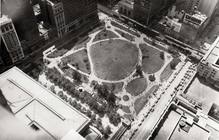
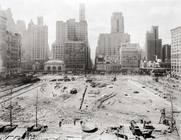
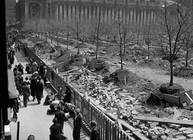
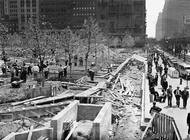
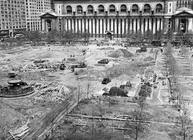
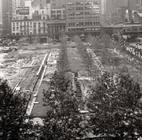

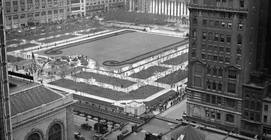

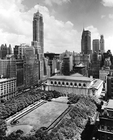
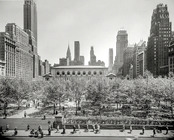
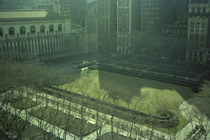

2018 Photos
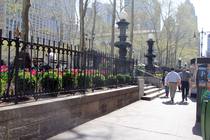

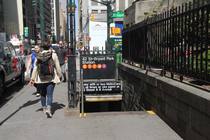
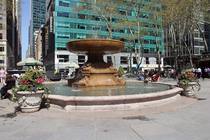
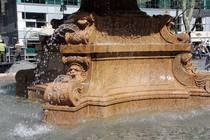
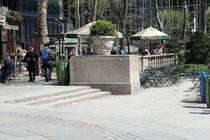

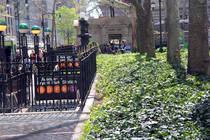


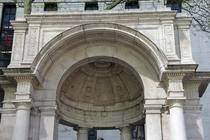
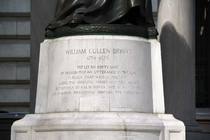
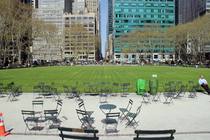



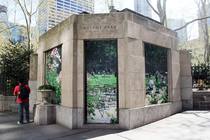
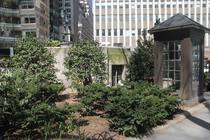
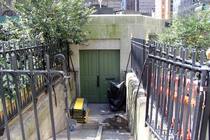
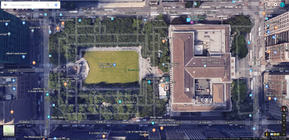

Bryant Park Free Open-Air Library
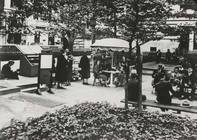

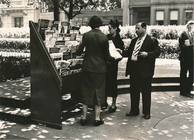
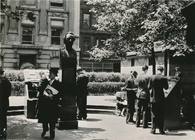


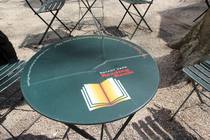
IND Sixth Avenue Line Bryant Park Station

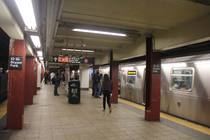
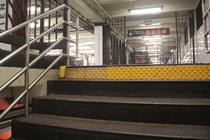
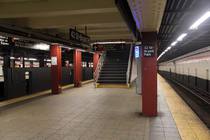
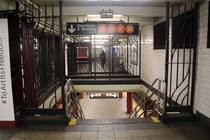
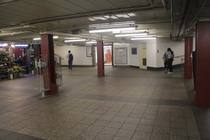

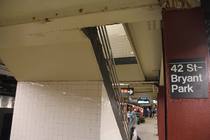
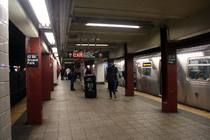

- Bryant Park, Wikipedia (accessed 1 May 2018).
- History, Bryant Park website (accessed 1 May 2018).
- Kumer, Ann, "From the Archives: The 1934 Moses Renovation of Bryant Park", Bryant Park Blog, 1 November 2010. The Bryant Park website gives absolutely no credit to the New Deal and all the credit to Parks Commissioner Robert Moses, personally.
- Caro, Robert A., The Power Broker - Robert Moses and the Fall of New York, Vintage Books (1974).
- Robert Moses and the Modern Park System (1929-1965), New York City Parks Department website (accessed 1 May 2018): "At the Parks Department headquarters in the Arsenal, an enormous park design and construction team assembled. Architect Aymar Embury II and landscape architect Gilmore D. Clarke were among the 1,800 designers and engineers drawing up plans for the expansion, rehabilitation and modernization of New York's parks. An additional 3,900 construction supervisors oversaw the work of an army of Parks Department relief workers — 70,000 strong in 1934 — all paid by the federal government."
- Aymar Embury II, Lehman College biography: "Embury was chief or consulting architect in numerous projects in New York City and supervised the design of over six hundred public projects. Surviving examples include the Central Park Zoo, Prospect Park Zoo, Prospect Park Bandshell, McCarren Park and four of the other ten WPA pools built throughout the city in the mid-1930s, the New York City Building at the 1939 New York World's Fair (Currently the Queens Museum of Art), Triborough Bridge, and Henry Hudson Bridge, Orchard Beach, Bryant Park, the Hofstra University Campus, and Jacob Riis Park."
- NYC Parks Department Press Release, 18 February 1934: "The Municipal Art Commission has approved the Department of Parks design for the construction of Bryant Park. Work will be started immediately and completed before the summer." Also "New Bryant Park Ready by Summer", New York Times, 18 February 1934, pp.74,76 (in response to the press release): "Plans for the immediate beautification of Bryant Park by CWA workers were announced yesterday by Park Commissioner Robert Moses ... It can be carried out at negligible expense to the city by the use of about 200 CWA employees ... CWA forces have been busy on sketches and engineering details ..." It goes on and on and is an excellent summary of the work that was done on the park by the CWA.
- "$80,000,000 Spent by CWA in This State", New York Times, 2 April 1934, p.1, says that the Civil Works Administration created the plan for the reconstruction of Bryant Park, meaning the plan was drawn up by Embury and Clarke during the period when they were paid by CWA (in 1935 they were switched to the WPA).
- "Parks Promises Kept", New York Times, 31 Dec 1934: Includes a quote from Robert Moses: "...the projects of 1934, with the exception of the parkways, were done almost entirely with relief labor." Then he cites the transformation of Bryant Park as one of the highlights of the year.
- "Work Relief Booms in Parks", New York Times, Thursday 11 October 1934, p.26: "The day of using relief workers to manicure grass or rake leaves from one side of the road to the other and back again has passed. In the last year emergency [i.e. relief] workers ... have completely restored and refashioned Bryant Park..."
- "New Bryant Park to Open on Aug. 28", New York Times, Tuesday 14 August 1934, p.15: "No funds were available for ehabilitating the park, and it remained in an unkempt state until the new Park Department decided it could be improved at once with relief labor."
- "Park Progress", New York Times, 17 May 1935, p.20: "New York is rapidly acquiring one of the finest systems of parks, parkways and playgrounds in the world. For current improvements and extensions it has chiefly Mr. Moses and the depression to thank. One has given direction to the work, the other, in the name of unemployment relief, has supplied the funds. These have been expended on a host of projects the city over [including] the rehabilitation of Bryant Park..."
- "Outdoor Library Proves Popular", New York Times, Sunday 25 August 1935, p.68: "Balmy days brought success early this week to the outdoor library in Bryant Park where bench-sitters found plenty of time on their hands to sample free literature provided by the city Works Progress Administration."
- "Open-Air Library Marks Birthday", New York Times, 18 August 1936, p.17: Notes that Bryant Park's open-air library is staffed by WPA workers.
- "WPA Administrator Here Reviews Expenditure of $409,195,154 Federal Funds", New York Times, Monday, August 16, 1937, p.8: Brehon Somervell, the New York City Works Progress Administrator, writes, "The eye-sore known as Bryant Park, in the center of the town, close to the public library, was typical of the smaller areas [that were rehabilitated with federal funds]". This is a full-page, 8-column article cataloging New Deal accomplishments in New York City, 1934-37.
- NYC Parks Department Press Release, December 1938, "Progress in the Park Department: 1934-1938": "Without doubt the greatest achievement of the past five year period of the park consolidation has been the increase, over three-fold, in recreational facilities and the general rehabilitation and reconstruction of park areas made possible by the relief program. While the number of relief workers in New York City parks has fluctuated since 1934, there has been a total of 200,000 man years of labor provided to the park program. Naturally this figure, which is difficult to understand, has produced many improvements of lasting benefit." It goes on to list numerous projects completed by relief labor, including "the entire reconstruction of Bryant Park".
- NYC Parks Department Press Release, 27 February 1940: Reproduces a long, rambling speech by Robert Moses, where he said: "I don't know yet how we got away with the Bryant Park reconstruction with so little difficulty. Perhaps it was because people were sick of the constant digging up and exploitation of this area, and because it was a shambles when the present administration took office."
- Excavation and Renovation, Citi Pond at Bryant Park website (accessed 1 May 2018).
- "Bryant Park Journal; After 3 Years, a Park Awaits a Wary Public", New York Times, 13 June 1991, p.33.
- Designation Report for Bryant Park, New York City Landmarks Preservation Commission, Number 9 LP-0879, 12 November 1974, which notes that the work was carried out by CWA workers under the supervision of the Parks Department in 1934. It was this version of the park that was landmarked.
- "Plan suggested for the Beautification of Bryant Park", New York Times, January 21, 1934 (cited in Ballon and Jackson, Robert Moses and the Modern City, Norton, 2007).
- Film: A Better New York City (WPA, 1937), shows recently reconstructed Bryant Park at 2:58 and the outdoor library at 5:06.